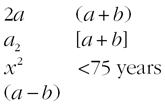AMA Manual of Style - Stacy L. Christiansen, Cheryl Iverson 2020
Spacing With Mathematical Symbols
Mathematical Composition
Thin spaces (a space character that is usually 1 ⁄ 5 or 1 ⁄ 6 the width of an em dash; the Unicode value for the 1/6 em space is 2009) should be used before and after the following mathematical symbols when they are used as verbs, conjunctions, or operators: ±, =, <, >, ≤, ≥, +, −, ÷, ×, ⋅, ≈, ∼, ∩, ∫, Π, Σ, and |. Examples follow.

When symbols are used as adjectives, they are set close to the number.
A temperature of —2 °C
![]()
The choice of <.05 as the value for statistical significance is essentially arbitrary.
All large polyps (≥20 mm) were resected.
The following are more examples of symbols set close to numbers, superscripts and subscripts, and parentheses, brackets, and braces.

Principal Authors: Lauren Fischer and Paul Frank
Acknowledgment
Thanks to Karen Boyd, formerly with JAMA Network, Rochelle Lodder, formerly with JAMA Network, and Paul Ruich, JAMA Network, for careful review of this chapter.Additional Information: Coauthor Paul Frank died in 2015.
References
1.Design Science. MathType. Accessed November 30, 2018. http://www.dessci.com/en/products/mathtype/
2.The LaTeX Project. LaTeX—a document preparation system. 2015. Accessed July 23, 2019. https://latex-project.org/
Additional Readings
Style Manual Committee, Council of Science Editors. Scientific Style and Format: The CSE Manual for Authors, Editors, and Publishers. 8th ed. University of Chicago Press/Council of Science Editors; 2014.
Swanson E, O’Sean A, Schleyer A. Mathematics Into Type. Updated ed. American Mathematical Society; 1999. Accessed July 23, 2019. https://www.ams.org/publications/authors/mit-2.pdf